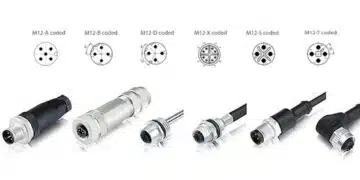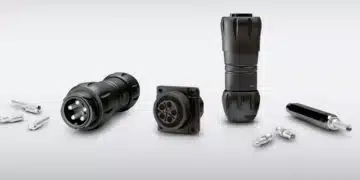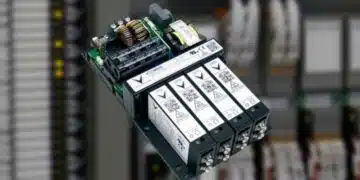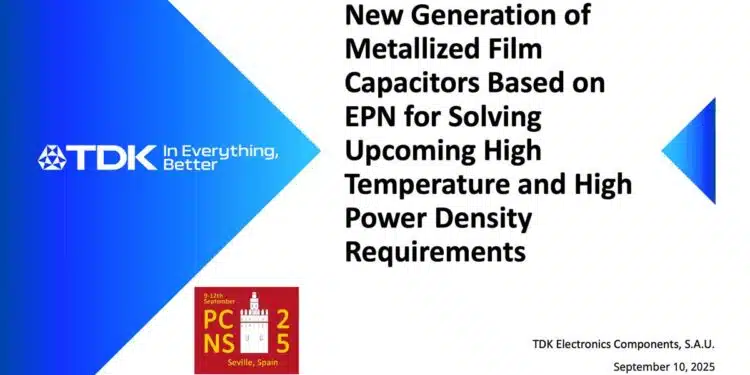The paper “New Generation of Metallized Film Capacitors Based on EPN for Solving Upcoming High Temperature and High Power Density Requirements” was presented by Manuel Gómez, TDK Electronics Components S.A.U., Málaga, Spain at the 5th PCNS Passive Components Networking Symposium 9-12th September 2025, Seville, Spain as paper No. 2.2.
Introduction
The article discusses the evolution of power electronics and the increasing requirements for high-temperature and high-power density components, particularly in DC-Link applications.
With the advent of Wide-Bandgap (WBG) semiconductors such as SiC and GaN and advancements in power module packaging, converters can now operate with greater efficiency and higher power densities.
This has created a challenge for supporting components like film capacitors, which must handle higher operating temperatures, faster transient responses, and maintain reliability over long lifetimes. This paper focuses on the development of a new generation of metallized film capacitors based on Ethylene-Propylene-Norbornene (EPN) to meet these demands, culminating in TDK’s ModCap UHP series.
Key Points
- WBG semiconductors enable higher efficiency, power density, and switching speeds, which increase the demand on DC-Link capacitors.
- Traditional BOPP (Biaxially Oriented Polypropylene) capacitors are limited by thermal and current-density constraints.
- EPN (Ethylene-Propylene-Norbornene) dielectric film blends PP with COC, offering enhanced high-temperature performance and self-healing properties.
- ModCap UHP capacitors, based on EPN, achieve a rated temperature of +105°C (up from +80°C) and a current density increase of up to 21%.
- In high current density DC-Link applications, EPN-based capacitors reduce volume, cost, and improve lifetime performance versus BOPP solutions.
Extended Summary
The evolution of power electronics technology is largely driven by semiconductor improvements, particularly the adoption of WBG materials like SiC and GaN. These devices provide faster switching, lower losses, and higher tolerances for temperature, enabling more compact and efficient converters. As a result, passive components such as DC-Link capacitors are required to operate at higher electric fields, with lower parasitics (ESR/ESL), and withstand elevated ambient and junction temperatures without sacrificing reliability.
TDK addressed these challenges by developing a new dielectric material called Ethylene-Propylene-Norbornene (EPN). This material is a blend of Polypropylene (PP), which is highly processable, and Cyclic Olefin Copolymer (COC), which offers excellent high-temperature electrical properties. Biaxially Oriented EPN (BOEPN) films retain the self-healing and voltage strength characteristics of BOPP at moderate temperatures. At higher temperatures, BOEPN demonstrates superior breakdown strength, lower leakage currents, and enhanced robustness, preventing thermal runaway even under DC stress.
By incorporating BOEPN into its modular high-power film capacitors, TDK launched the ModCap UHP series. These capacitors retain the modularity, low ESL (8 nH), low ESR, and high reliability of the ModCap HF line but extend the rated operating temperature from +80°C to +105°C. The current density gains of up to 21% translate into improved converter power density by as much as 45%, while maintaining a 200,000-hour lifetime without derating. Long Endurance Test (LET) results demonstrate that ModCap UHP can operate at its higher rated temperature with similar aging performance to ModCap HF at lower temperatures.
Application analyses confirm the practical benefits of EPN-based capacitors in high current density DC-Link configurations. In a 1600V, 1850µF, 570Arms application, a solution using ModCap UHP required only three capacitors, compared to five BOPP-based ModCap HF units, achieving a 40% reduction in DC-Link volume and 25% cost savings. Finite Element Method (FEM) simulations verified that the UHP solution maintains internal temperatures below rated limits, ensuring full lifetime performance.
These enhancements directly address the thermal and volumetric challenges in next-generation energy storage, solar inverters, DC/DC converters, and drives utilizing advanced SiC modules.
Conclusion
The development of EPN dielectric film and its implementation in the ModCap UHP series represents a significant advancement in metallized film capacitor technology. EPN enables operation at higher temperatures and current densities without compromising reliability or lifetime. For high power density DC-Link applications, ModCap UHP capacitors deliver reduced size, lower cost, and robust thermal performance, making them a superior alternative to traditional BOPP-based solutions in the era of WBG semiconductors.
































